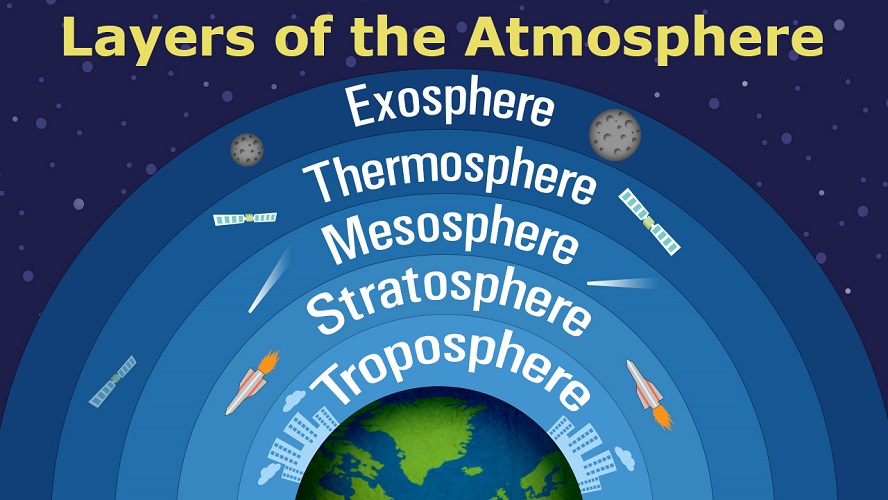What is the atmosphere?
We explain what an atmosphere is and what is the importance of the Earth’s atmosphere. Layers and characteristics of the atmosphere.
-
What is the atmosphere?
We call the more or less homogeneous ball of gas atmosphere concentrated around a planet or celestial star and held in place by gravity . On some planets, composed mostly of gas, this layer can be particularly dense and deep.
The Earth’s atmosphere reaches about 10,000 km away from the planet’s surface , and it houses in different layers the gases necessary to preserve the stable planetary temperature and allow the development of life . The air currents present in it are closely related to the hydrosphere (the set of planetary water ), and are reciprocally affected.
Our atmosphere can be divided into two large regions: homosphere (the bottom 100 km) and heterosphere (from 80 km to the outer edge), according to the variety of gases that make up each, much more varied and homogeneous in the first, and stratified and differentiated in the second.
The origin and evolution of the atmosphere date from the very beginning of the planet, in which a thick layer of primal gases remained around the planet, constituted mostly by hydrogen and helium from the solar system . However, the gradual cooling of the Earth and the very later appearance of life were changing the atmosphere and varying its content until we reach what we know today, through processes such as photosynthesis and chemosynthesis or breathing .
-
Characteristics of the atmosphere
The Earth’s atmosphere is composed of various types of gases , whose highest percentage of mass accumulates in the first 11 km high (95% of the air is in its initial layer) and whose total mass is around 5.1 x 10 18 kg .
The main gases that integrate it (in the homosphere) are nitrogen (78.08%), oxygen (20.94%), water vapor (between 1 and 4% at the surface level) and argon (0.93%) . However, other gases are present in minor amounts, such as carbon dioxide (0.04%), neon (0.0018%), helium (0.0005%), methane (0.0001%), among others .
For its part, the heterosphere consists of differentiated layers of molecular nitrogen (80-400 km), atomic oxygen (400-1100 km), helium (1100-3500 km) and hydrogen (3500-10,000 km).
The atmospheric pressure and temperature decrease with height, so the outer layers are cold and not very dense.
-
Layers of the atmosphere

The Earth’s atmosphere is composed of the following layers:
- Troposphere . The initial layer, in contact with the earth’s surface, where the greatest amount of atmospheric gases accumulates. It reaches 6 km in height at the poles and 18 km in the rest of the planet, being the warmest layer of all, although in its outer limits the temperature reaches -50 ° C.
- Stratosphere . It goes from 18 to 50 km high, in various soda layers. One of them is the ozone atmosphere, where solar radiation impacts on oxygen, forming ozone molecules (O 3 ) that constitute the well-known “ozone layer”. This process generates heat, so the stratosphere registers a considerable increase in temperature to -3 ° C.
- Mesosphere . The intermediate layer of the atmosphere, between 50 and 80 km high, is the coldest zone of the entire atmosphere, reaching -80 ° C.
- Imosphere or thermosphere . It extends from 80 to 800 km high and has a very dense air that allows drastic temperature oscillations depending on the solar intensity: it can record temperatures of 1500 ° C during the day and fall dramatically at night.
- Exosphere . The outer layer of the atmosphere, which ranges from 800 to 10,000 km high, is relatively undefined, little more than the transit between the atmosphere and outer space. There the leakage of the lighter elements of the atmosphere, such as helium or hydrogen, takes place.
-
Importance of the atmosphere
The atmosphere plays a vital role in the protection of the planet and therefore also of life . Its density deflects or attenuates the forms of electromagnetic radiation coming from space, as well as any possible meteorites and objects that could impact its surface, most of which dissolve by rubbing with the gases when entering it.
On the other hand, in the stratosphere is the ozone layer ( ozone ), an accumulation of this gas that prevents direct access of solar radiation to the earth’s surface, thus maintaining the temperature of the planet stable. At the same time, the mass of gases prevents the rapid dispersion of heat into space, in what is called the ” greenhouse effect “.
Finally, the atmosphere contains the essential gases for life as we know it, and plays a vital role in perpetuating the water cycle of evaporation, condensation and precipitation of water.





